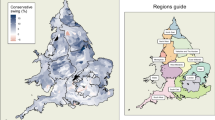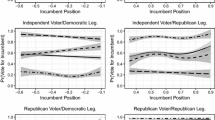Abstract
We model correlated voter-candidate issue data within the framework of the Enelow-Hinich spatial model of predictive dimensions. The empirical consequences of this model of the issue data are surprising and allow for an indirect test of the Enelow-Hinich spatial model. The central prediction of the correlated data model we construct, which depends critically on the underlying spatial model, is tested with issue data from the 1980 NES pre-election interview. The test results are highly supportive of the model's predictions. We conclude both that the spatial model of predictive dimensions is empirically supported and that candidate spatial locations estimated by the model are not an artifact of correlated voter-candidate issue data.
Similar content being viewed by others
References
Anderson, T.W. (1984).An introduction to multivariate statistical analysis. Second Edition. New York: Wiley.
Anderson, T.W. and Amemiya, Y. (1988). The asymptotic normal distributions of estimators in factor analysis under general conditions.The Annals of Statistics 16(2): 759–771.
Brody, R. and Page, B. (1972). Comment: The assessment of policy voting.American Political Science Review 66: 450–458.
Downs, A. (1957).An economic theory of democracy. New York: Harper & Row.
Enelow, J. (1986). Measuring the linkage between predictive dimensions and candidate issue positions: An examination of group differences.Political Behavior 8(3): 245–261.
Enelow, J. and Hinich, M. (1984).The spatial theory of voting: An introduction. New York: Cambridge University Press.
Long, J.S. (1983).Confirmatory factor analysis. Sage University Paper series on Quantitative Applications in the Social Sciences, series no. 07-033. Beverly Hills and London: Sage Publications.
Morrison, D. (1976).Multivariate statistical methods. Second Edition. New York: McGraw-Hill.
Page, B. and Brody, R. (1972). Policy voting and the electoral process: The Vietnam War issue,American Political Science Review 66: 389–400.
Page, B. and Jones, C. (1979). Reciprocal effects of policy preferences, party loyalties and the vote.American Political Science Review 73: 1071–1089.
Rao, C.R. (1955). Estimation and tests of significance in factor analysis.Psychometrika 20: 93–111.
Tukey, J. (1977).Exploratory data analysis. Reading MA: Addison-Wesley.
Author information
Authors and Affiliations
Additional information
The authors wish to thank Ben Page, Eric Devereux, and an anonymous referee for their helpful comments. An earlier draft of the paper was delivered at the 1989 Public Choice Society Meetings, Orlando, Florida. This work was partially supported by the National Science Foundation under Grant # SES 8310591.
Rights and permissions
About this article
Cite this article
Enelow, J.M., Hinich, M.J. A test of the predictive dimensions model in spatial voting theory. Public Choice 78, 155–169 (1994). https://doi.org/10.1007/BF01050392
Accepted:
Issue Date:
DOI: https://doi.org/10.1007/BF01050392




